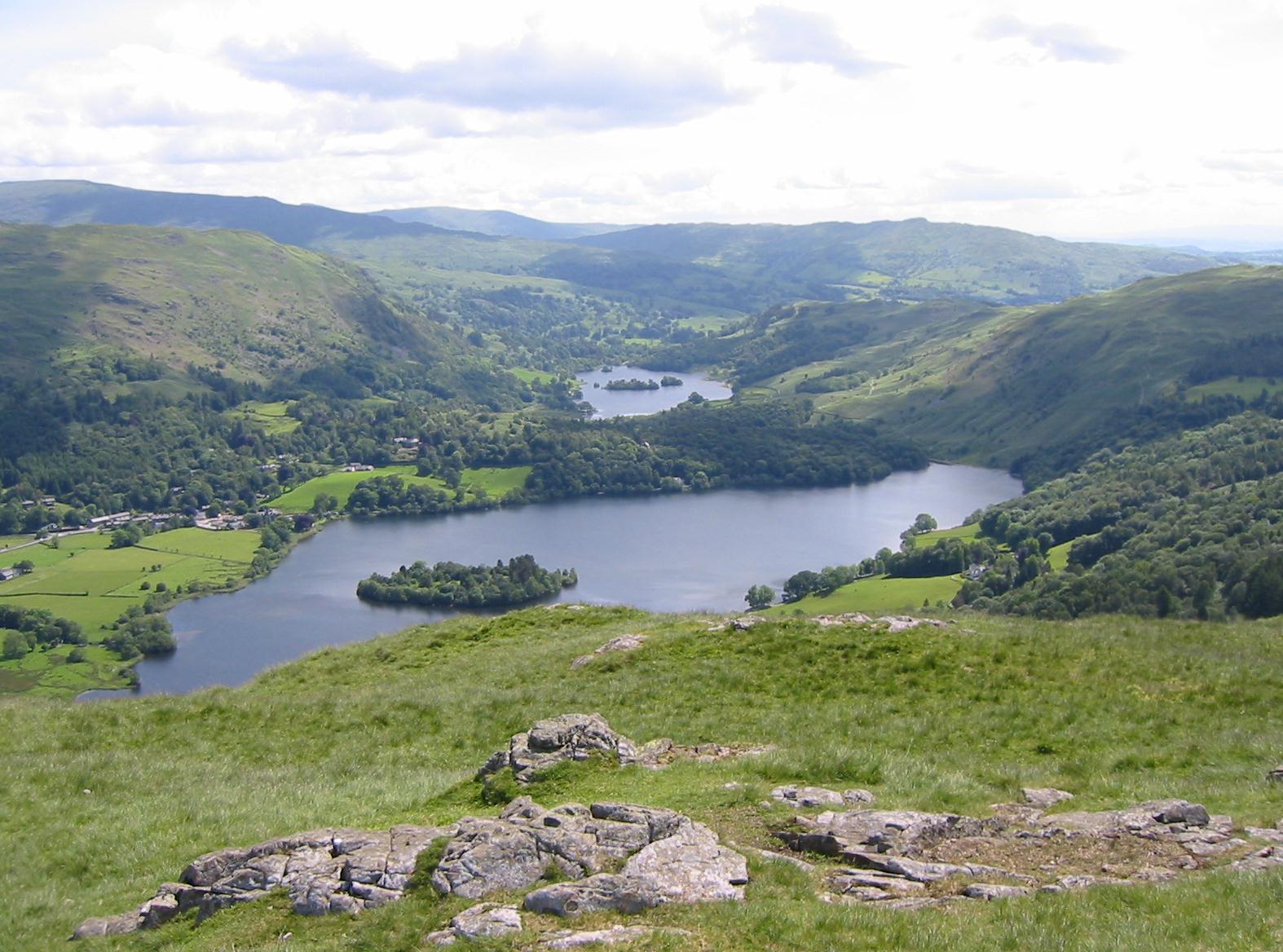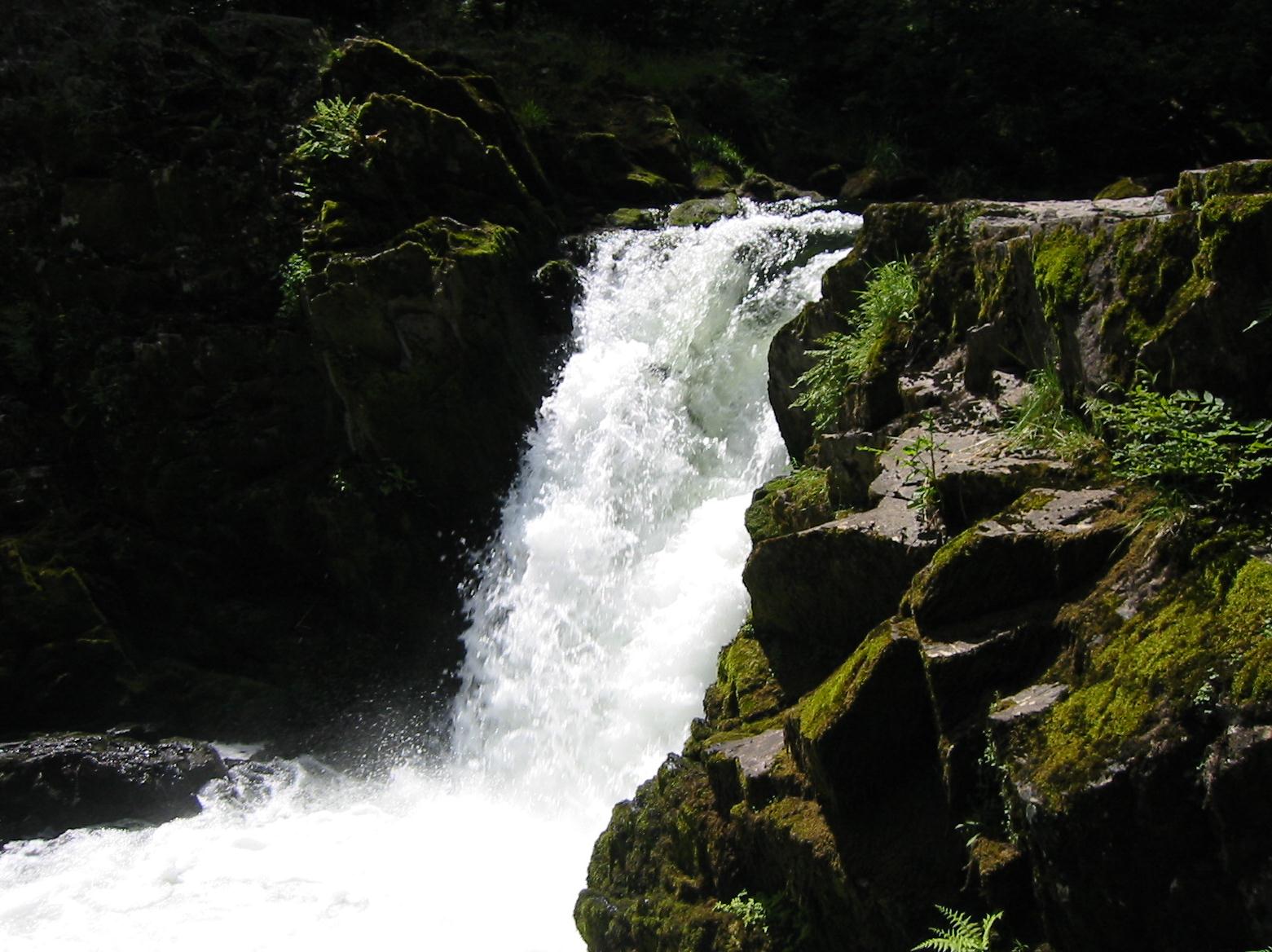June 20, 2005: Grasmere to Skelwith Bridge
We were obviously heading into another lovely day in Lakeland. To celebrate, Tosh actually added a Cumberland sausage to her breakfast order – and so did I. I received a series of taxi phone numbers from our host and, after quite a battle with busy signals, no answers, and answer machines, I secured the services of the Grasmere taxi itself.
In my original plans for today I had wanted to walk from Grasmere to Ambleside, some eight and a half miles on Hannon’s route, get a taxi there, have it take us back to Grasmere (where we would retrieve our bags) and then ferry us forward to the train station at Windermere – where we now had reservations on the 4:41 train. Our tired legs and the ups and downs of today’s route had now convinced me that this was too ambitious a project, and so I arranged to be picked up at Skelwith Bridge at 3:00 – a distance of only five miles or so. All of the other details would be unchanged and this would leave a nice eight-mile opening day to Troutbeck for the resumption of our adventures on a second Westmorland Way trip.
We bought no food this time and began our march at about 10:00. We were well situated to find the lane described by Hannon, one in the village center by a cafe next to an artist’s studio that faces onto the green. This soon lead to a fork; we took both right and left – right was the correct choice, though left did bring us up to Allan Bank, the third of Wordsworth’s Grasmere homes. The right fork brought us by a farmstead with wonderful views of the northern panorama. I pointed out the notch in the skyline representing the pass that had brought us into the valley of Tongue Gill – Margie could not believe that she had stood on that elevated spot only yesterday.
A gate admitted us to a steeply rising enclosed path (often doubling as the local stream) and we emerged from this into more open country amid juniper bushes. From here we could see back down to Grasmere – but all of my attentions were concentrated on finding the right path for a descent to Wray Gill. The two cairns that Hannon suggested we could use as evidence for such a turnoff were not in evidence this morning, but I was pretty sure that the rocky gully on our left must be the right one – so we plunged down to it and climbed up to the moorland beyond. Here we had to head south in hope alone, but a chain of cairns and a faint trod (not to mention other walkers) encouraged me to believe that we were actually on the route to Silver How.
There were a few steep sections on this ascent and a few juicy ones as well, but it did not take us too long to reach the summit of this peak; at 1292 feet it was well-situated for marvelous views of Grasmere village below us, as well as a variety of bodies of water including Grasmere itself, Rydal Water, Elterwater and Windermere and, to the west, a sighting of the Langdale Pikes. There were other walkers up here as well. We had a nice rest in the brilliant sunshine.
The next section of the route was a bit more problematic. Hannon calls for a continuation in the southerly direction we had used to ascend the peak, with a large cairn serving as the next landmark. This is not as simple a descent as such a description would imply – since there were a number of paths and the cairn was not immediately apparent. I used my compass a lot up here, but I think my route was slightly too far to the west – for when I was certain that I could see the required cairn we had to improvise a route over to it on juicy and pathless grassy slopes.
Arrived at last, the next section seemed easier to follow. We began our plunge into Langdale by dropping down to a level path and turning left to approach another cairn at a junction of paths. We could already see Chapel Stile below us – “I think I can see my pint,” I said. Our route required us to descend along a rocky path that swung to the west in order to cross Megs Gill, where waterfalls plunged steeply. Scrambling over the beck we began a steep descent amid bracken, Tosh wanting to make sure that the left-hand fork, which seemed to aim directly for Chapel Stile, was really to be avoided. It was – in favor of a second turnoff in the bracken on a path that seemed to curve to the left and reach a plateau above our village. But I knew that no change of direction was called for here and backtracked to a point where we could continue forward down a rocky gully, very steeply. There were cries of protest behind me, but I persevered and reached a stream near the abandoned Thrang Quarry.
We crunched forward through this stony landscape, but I was seduced by a footpath sign pointing to the right. This path seemed to lead nowhere, and so I backtracked in time to head off the others, one of whom had by now discovered a second footpath sign pointing downhill to the left. This I knew to be our route. It lead us out to a lane in a corner of Chapel Stile, where we marched forward in bright sunlight past the church and turned right. Here we encountered for the first time a sign, in a car window, protesting the National Park Authority’s decision to limit the speed of boats on Windermere to ten miles a hour, a prohibition which effectively meant the end of noisy water skiing on the lake. Go NPA!
Our lane reached the main Langdale Road, and here we turned left, our pub just around the corner. Ironically called Wainwrights Inn, this establishment celebrated only the efforts of the craftsman, not the mountain man. All the remaining outdoor tables were in the hot sun so we took an indoor booth and enjoyed our cold drinks. It was shortly after 1:00.
We now had just two miles or so to go, amid wonderful riverside scenery provided by our old friend, the Great Langdale Beck. We left the B5343 behind at Chapel Stile, crossed over the beck on a footbridge and climbed up a hill to a paved quarry road. Tosh explored the mouth of a cave here and then we used the road to descend onto the Elterwater road. Without telling the others what I was up to, I turned right here (instead of the required left) so that I could lead Tosh back to the youth hostel where we had spent a night with wet kids in 1984. Then we turned around and reached Elterwater village, disdaining a stop at the Britannia pub in favor of a direct assault on Skelwith Bridge.
The footpaths here had been improved as well and it was hard to recapture the muddy memories of fighting our way along this section in the pouring rain. I took quite a few pictures along the route, several of the clear waters with their rock pools – and the other walkers got some distance ahead of me here.
We entered a wooded section close to the lake itself and emerged, along with the River Brathay, in open country of great charm. There were swarms of trippers about, including a large contingent of picnicking French visitors. As we neared Skelwith Force Tosh insisted on missing out altogether on a return visit to the falls, and she and the others raced ahead to refreshments and loos while I climbed out on the rocks and took some pictures.
The scene was much changed at Skelwith Bridge – the showroom and cafeteria of the slate factory were not where I expected to find them at all, and I had some trouble locating my missing trio. They were lining up for coffee and pastries in Chester’s cafe. I joined them (this was the spot that the cabby had specified as our meeting place), and got down my own scone and bits of everyone else’s cake. We had walked fifty-five miles altogether, and our expedition was now at an end.
There was a long wait for the loos and while I was queuing I spotted our cab, ten minutes early at 2:50. After I had extracted the girls from the shop we set off at great speed on tiny back roads for Grasmere. Here we retrieved our packs from the vestibule of the Harwood Hotel while Tosh, with the meter running, sneaked across the street into a gift shop to buy her daughter-in-law a present.
Then we were off for Windermere on a very busy highway that took us past a number of well-remembered scenes, including Ambleside itself. Our cabby was quizzed mercilessly by Tosh on a number of topics. He didn’t approve of the ban on speedboats, he noted that there are now only a few winter months that are out of season, and that people tend to stay for shorter periods than in the old days. He said he also went on walking holidays too – to Morocco and Turkey.
We were dropped off at Windermere station with a little over an hour to go and we entered the adjacent supermarket, which had its own cafe. Here we sat making adjustments to our packs. I attempted to get the legs back onto my trousers, got the zipper jammed and had to sneak into the men’s room in order to switch into my khakis. Margie ate some cold chicken and I drank a lukewarm Diet Coke.
At about 4:30 we went into the waiting room and a few minutes later climbed aboard our shuttle for the 4:41 service to Oxenholme. Just before boarding our train I tried to loft my heavy backpack onto my shoulder, using my right arm only, and I could feel a great tug on the muscles running all the way into my chest as a consequence of so foolish a gesture. The ride to Oxenholme also provided well-remembered scenery, but this time I saw a young deer from my window. After twenty minutes we detrained and crossed over to the mainline platform. I asked a guard where we might locate our carriage so we were well situated to climb aboard our Virgin train at 17:07. Our seats were soon located and we began to speed south.
I had hoped to nod off on this section but there was too much activity and too much noise (mobile phones, announcements and the non-stop chatter of an eight-year old), so I did two puzzles instead. We made a visit to the buffet car and I dined on an egg mayonnaise sandwich, a bag of crisps, and a bottle of Fanta. This train too fell well behind schedule but it picked up the lost minutes and we arrived on time at Euston at 8:30.
I said goodbye to my walking companions after a very successful and, thankfully, incident-free outing. The others were heading toward the underground at the insistence of the parsimonious Tosh, but I took the escalator into the basement, grabbed a cab and reached home swiftly. I too liked the new opal shade of the sitting room.
To continue with the next stage of our walk you need:



